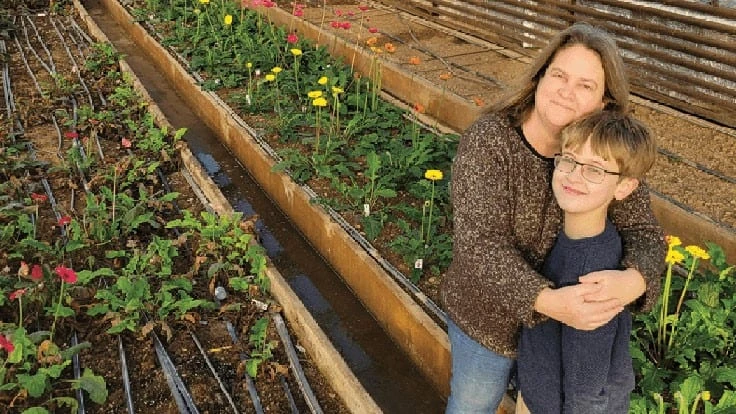

As a fourth-generation flower grower, Sue Ellen Hendricks grew up knowing she was destined for the family’s greenhouse. Both of her paternal grandparents were raised on carnation farms in two neighboring towns outside of Philadelphia. In 1937, they purchased a carnation growing facility in Lititz, Pennsylvania, and expanded throughout the 1950s by adding more greenhouses and a small retail shop.
“The greenhouse started out at the edge of town, and as development happened, the town absorbed us,” Sue Ellen explains. The “cutesy little agricultural community” of Lititz looks like the setting of a Hallmark movie, she says — and in fact, it has been featured in films before.
Although the times have changed since her grandparents started growing at this location, Sue Ellen works hard to keep the charm of fresh, local flowers alive.
“We’ve been able to push through and survive because of the quality product that we’re supplying customers,” Sue Ellen says, explaining that the business is now 90% retail. “We’re really unique in the fact that we … are growing a lot of our own cut flowers for our shop.”
Today, Hendricks’ Flowers spans six greenhouses with a total production space of 33,000 square feet. By blending proven practices with a diversity of new varieties, the Hendricks family keeps adapting to continue growing fresh cut flowers.

Keeping the classics
In the early days, Sue Ellen’s grandfather, Clyde Hendricks, primarily grew carnations and chrysanthemums for the wholesale market in Philadelphia. Back then, “it was a whole-family operation,” she explains, “where grandma would help disbud carnations, my aunt would answer the telephones and everyone would chip in to clean crops.”
While Sue Ellen’s brother started working in the greenhouse full-time after high school, she went off to study plants to help advance the family business. After earning a degree in ornamental horticulture and a master’s in soil chemistry, Sue Ellen joined Hendricks’ Flowers in 1995. By that time, her dad was taking over the greenhouses, with her mom running the retail shop.
“My father was very open to my [ideas] about what else we could grow,” she says. “Gerbera daisies were always my favorite, so that was the first crop [I added]. From that point, we increased the diversification of our greenhouses. Now, we probably have 70 different varieties.”
The greenhouse grows everything from freesia and calla lilies to lisianthus, tulips and cut poinsettias, alongside new varieties like butterfly ranunculus. Diversification keeps the retail supply fresh — especially as classic flowers like carnations get harder to find because domestic suppliers have closed down and international quarantine requirements have made imports impractical. Now, instead of having several greenhouses full of carnations, Hendricks maintains one small bed.
“It’s an old-fashioned variety called Lavender Lace that smells like cloves, which is what carnations smelled like in my grandfather’s day before they were genetically altered for stronger stems and higher petal counts,” Sue Ellen says. “It’s a crop our customers ask for and look forward to.”

Improving processes
When Sue Ellen first added gerbera daisies to Hendricks’ inventory, her grandfather warned her, “Get your spray mask ready, because you’re going to be spraying for whiteflies every week,” she recalls. Instead, she started releasing beneficial insects to control pests naturally. “We put out Encarsia formosa once a week,” she says, “and we don’t have to spray for whitefly because the beneficial insects take care of that for us.”
She also updated the operation by installing temperature sensors in the greenhouse and contact sensors on the boiler and coolers to help her keep an eye on the environment. This is a huge improvement from her grandpa’s old-school approach when he lived next-door to the facility, before his death in 1996.
“My grandfather’s method of checking the greenhouse was to shine a flashlight out of his window to see if there was frost on the greenhouses,” she remembers. “If [he saw frost], he knew it was too cold, and he’d come sleep on one of the workbenches.”
Looking ahead
Sue Ellen’s father, Bob, and mother, Bernie, are still active in the family business. As the friendly face of the company, Bernie often reminds long-time customers what flowers they ordered 30 years ago. At age 84, Bob still helps Sue Ellen plant carnations and chrysanthemums to keep the family tradition growing strong.
Her brother, John, handles the greenhouse crops. With a staff of four in the greenhouse and about 20 in the flower shop, Sue Ellen says some employees have been at Hendricks for almost 50 years — making the team feel more like family.
“We’re a good team,” she says, “but as far as the business continuing in our family, I’m going to leave that up to my son.”
Although her 10-year-old son, Alden, began helping in the greenhouse as soon as he could walk, Sue Ellen says it’s too early to tell where his interests will lead. Plus, Sue Ellen is only 51, “so it’s not time to decide yet,” she says. “In our family, you don’t retire — you just keep growing.”

Explore the March 2022 Issue
Check out more from this issue and find your next story to read.
Latest from Greenhouse Management
- North Carolina Nursery & Landscape Association announces new executive vice president
- Plant Development Services, Inc. unveils plant varieties debuting in 2025
- Promo kit available to celebrate first National Wave Day on May 3
- Applications now open for American Floral Endowment graduate scholarships
- Endless Summer Hydrangeas celebrates 20 years with community plantings
- Invest in silver
- Garden Center magazine announces dates for 2025 Garden Center Conference & Expo
- USDA launches $2 billion in aid for floriculture growers





